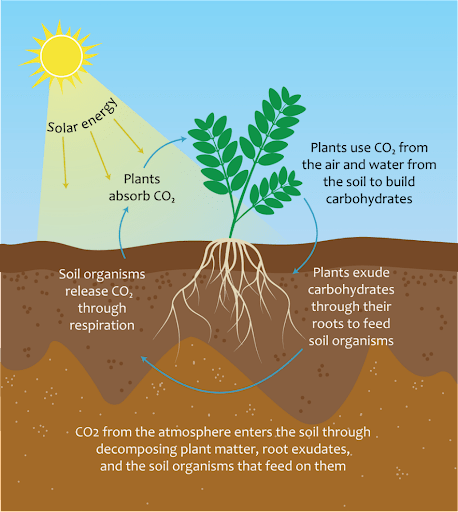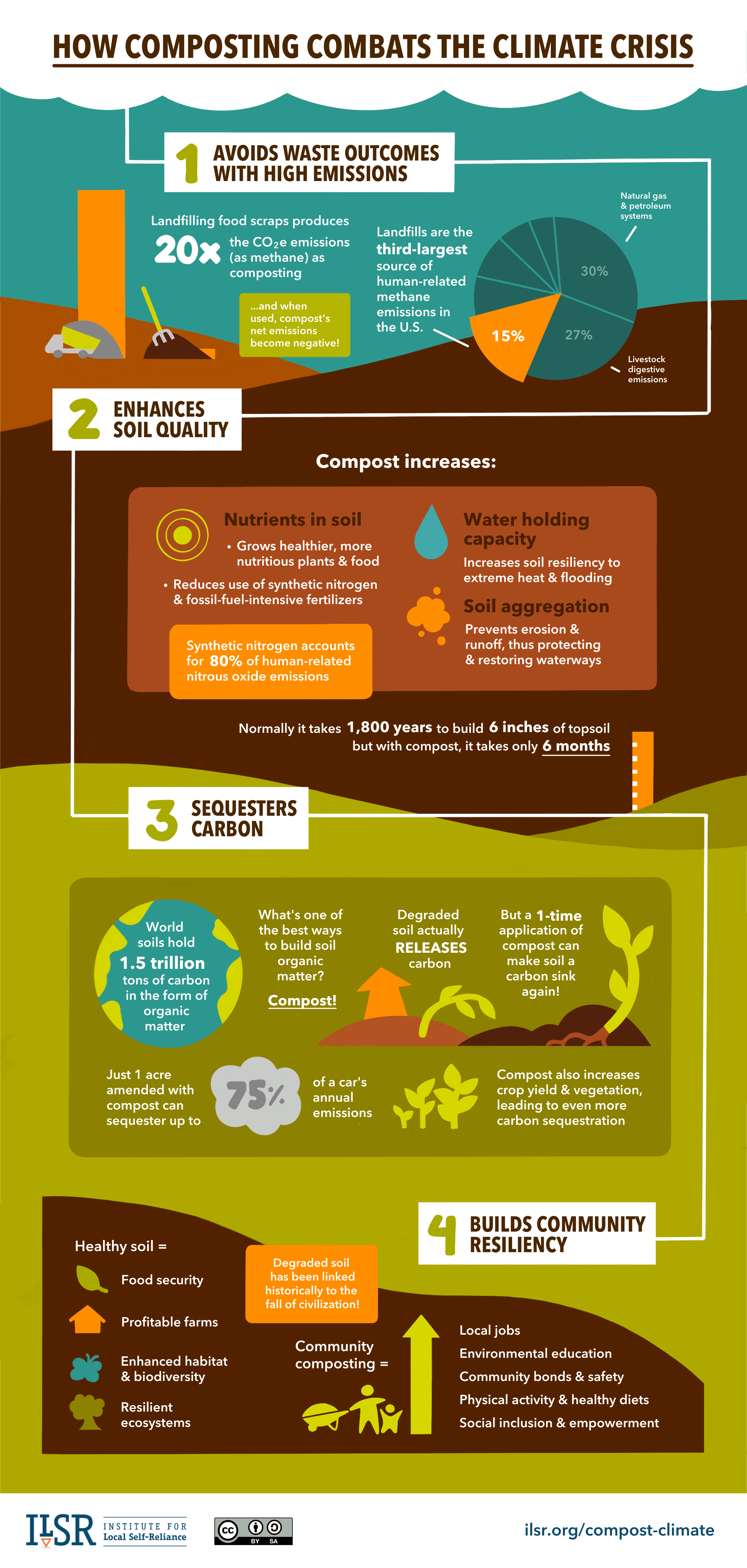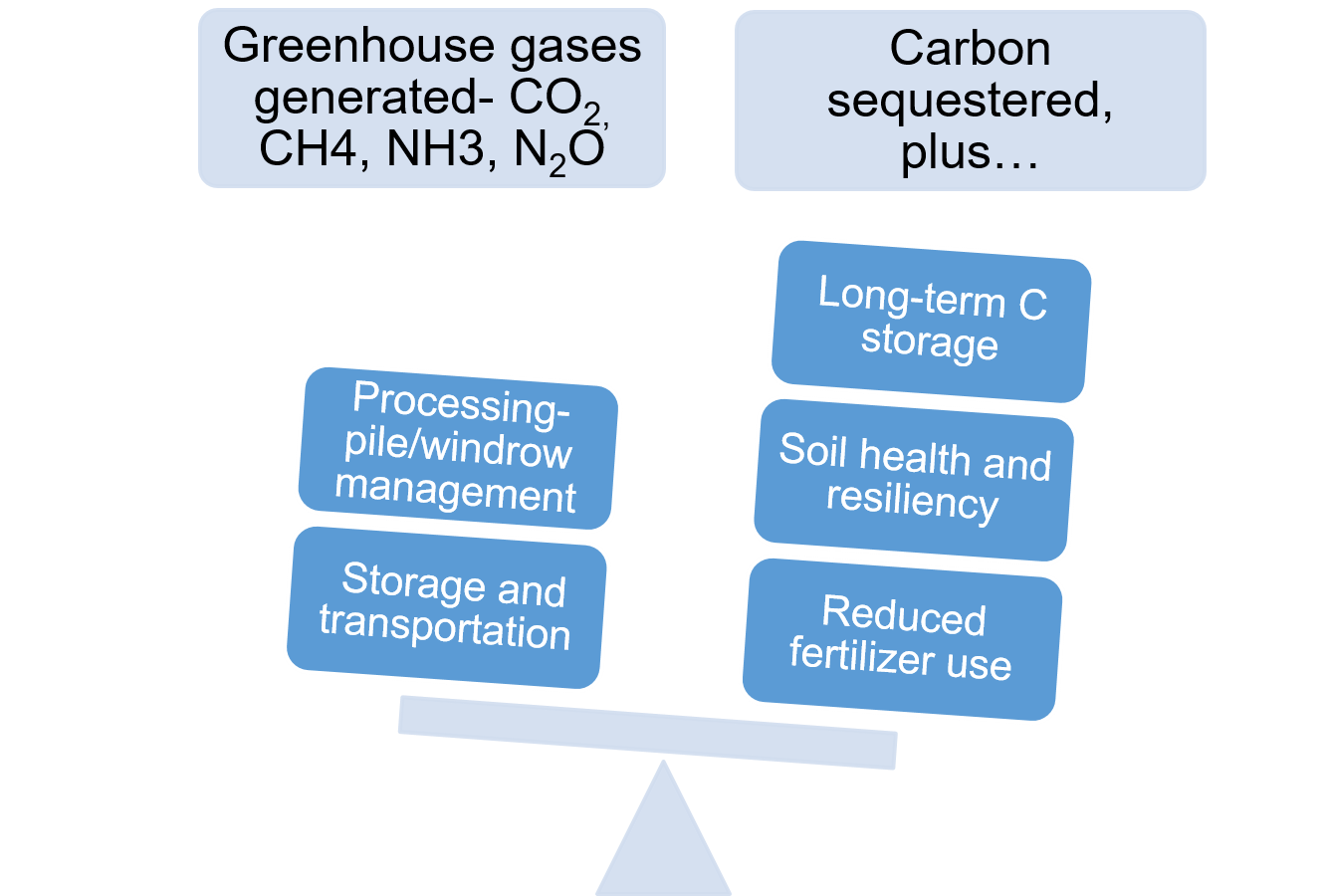Composting is probably seen by most people as good for gardens and the environment. After all, compost helps make our soils and plants healthier and keeps green waste from our yards and kitchens out of landfills.
But is composting good in the context of our climate crisis? Doesn’t the composting process generate lots of carbon dioxide (CO2), the principal greenhouse gas (GHG) that traps heat in Earth’s atmosphere? Can composting also mitigate climate change and make our yards and landscapes more climate-resilient? The answer to both questions is YES. This article will show that composting, at the home, community, and municipal/commercial level, is an important global warming mitigation and adaptation tool. As we’ll see, the ways that humans manage this natural process and use the compost can affect the climate benefits.
Composting basics
We don’t make compost! Huge populations of microorganisms do most of the work and we humans manage the process for our benefit. It’s nature’s way of recycling anything that lives and dies, like plants, animals, and microbes.
The decomposition process produces lots of carbon dioxide (CO2), part of the world’s carbon cycling system shown in this graphic:

This CO2 release is considered biogenic (happens through natural biological systems), not anthropogenic (people-made), and is not included in the calculations of greenhouse gas (GHG) emissions that drive global warming and climate change.
The three primary GHGs are:
- Carbon dioxide (CO2) — 300-1,000 year atmospheric lifetime; 86% of total GHG emissions
- Methane (CH4) — 84X the global warming potential of CO2; 12 year atmospheric lifetime; 7% of total GHG emissions
- Nitrous oxide (NO2) — 265X the global warming potential of CO2; 100 year atmospheric lifetime; 6% of total GHG emissions
There are many factors that determine the potential for composting to generate methane and nitrous oxide, like the mix of materials being composted, temperature, moisture, pile size and configuration, and aeration. Compost piles and windrows that are waterlogged and low in oxygen (anaerobic) are more likely to generate these GHGs. Composting is “climate-friendly” when it’s done in the presence of air (aerobic). Home and community composters turn piles by hand to keep them aerated and large-scale composting facilities use mechanical turners and force air into windrows with blowers. Well-managed composting at any scale releases very little methane or nitrous oxide into the atmosphere.
Direct climate benefits of composting
- Dumping food wastes and grass clippings in landfills generates large amounts of methane because the decomposition process is anaerobic. Landfills release about 17% of total U.S. anthropogenic methane emissions and food waste makes up 24% of landfill space. Burning organic wastes releases GHGs and toxins. Composting these organic wastes using best practices greatly reduces emissions.
- Carbon sequestration: Compost continues to degrade after soil incorporation. Some of the carbon cycles through soil microorganisms and some is held tightly to clay particles, protected against decomposition, and becomes part of the long-term reserve of stored carbon.
Indirect climate benefits of composting
The mid-Atlantic climate is becoming wetter and warmer overall, punctuated by localized extreme weather events, like record-breaking rainfall and extreme drought and heat. Intense storms can cause soils and nutrients to wash away and warmer temperatures cause more rapid organic matter decomposition and turnover, especially if soils are tilled and uncovered.
Adding compost to soils makes them more resilient by:
- Holding more water in the soil during periods of drought and extreme heat
- Reducing erosion (washing away of soil during extreme rainfall) and nutrient run-off) due to improved soil structure (larger, more stable aggregates or crumbs)
- Improving plant growth, by slow release of plant-available nutrients
- Reducing the need for synthetic nitrogen fertilizers which require natural gas for their production
- Reducing the need for potassium and phosphorous fertilizers (derived from mined mineral deposits that are dwindling worldwide)
- Binding and degrading toxic metals and pollutants
- Substituting compost for peat products can help reduce the release of CO2 from commercial peat extraction from wetlands

Home composting
Managing and recycling as much yard waste as possible on-site is often the most climate-friendly approach because it reduces GHG emissions from transporting and processing or landfilling organic waste. You can do this by recycling grass clipping (“mow ‘em high and let ‘em lie”), mulch-mowing tree leaves and leaving them in place, or using them as mulch, composting yard and garden waste, and burying kitchen scraps. These practices help to recycle nutrients on-site and increase soil organic matter. Selecting or building a non-plastic composter can also help reduce GHG emissions.
Municipal/commercial composting
This is the next best option for organic wastes that cannot be managed on-site. Commercial and municipal composting operations do create GHG emissions from the trucks and equipment, powered by fossil fuels, that are used to collect, transport, and process organic waste and compost. The closer the source of organic waste to the facility the lower the emissions and the greater the benefits. On balance, composting on a large scale can also help mitigate climate change.

To summarize: aerobic composting reduces GHG emissions compared to the landfilling and incineration of organic wastes. The resulting compost sequesters carbon when mixed into soils and improves soil health and resiliency. Composting at home and in your community is the most climate-friendly approach but commercial and municipal composting is another important tool that helps mitigate climate change.
References
- Silver, W. L., Vergara, S. E., & Mayer, A. (2018). Carbon sequestration and greenhouse gas mitigation potential of composting and soil amendments on California’s rangelands. California Natural Resources Agency, 62.
- Linzner, R., & Mostbauer, P. (2005, October). Composting and its impact on climate change with regard to process engineering and compost application-a case study in Vienna. In Proceedings of Sardinia Tenth International landfill Symposium, Cagliari, CISA publisher.
- Institute for Local Self-Reliance- Community Composting
- U.S. Composting Council- Greenhouse Gases and the Role of Composting: A Primer for Compost Producers (includes some research studies on GHG emissions and composting facilities)
- Maryland Department of the Environment- Organics Diversion and Composting
- U.S. EPA- Overview of Greenhouse Gases
Author: Jon Traunfeld, Extension Specialist, University of Maryland Extension Home & Garden Information Center
